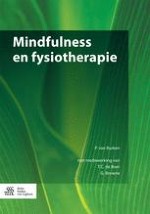Samenvatting
Mindful bewegen bevordert de corticale plasticiteit en kan de bewegingskwaliteit van de patiënt verbeteren, vooral als er traag, precies, aandachtig, onderzoekend, gevarieerd en herhaald bewogen wordt. Hoewel externe aandacht tijdens het bewegen vaak gunstig is voor de uitkomsten van het bewegen, laten we in dit hoofdstuk zien dat interne aandacht gericht op proprioceptieve bewegingssensaties ook een plaats binnen de fysiotherapie verdient. De Feldenkraismethode vertegenwoordigt mindful bewegen bij uitstek en past naadloos binnen een fysiotherapeutische setting. Bewegingskwaliteit is een lichamelijke focus die, gecombineerd met externe doelaandacht, tot optimale beweeguitkomsten leidt. Bewijs wordt aangeleverd dat mindful bewegen een gepaste interventie is voor patiënten met chronische pijn, stressgerelateerde problematiek en centraal-neurologische problematiek.
